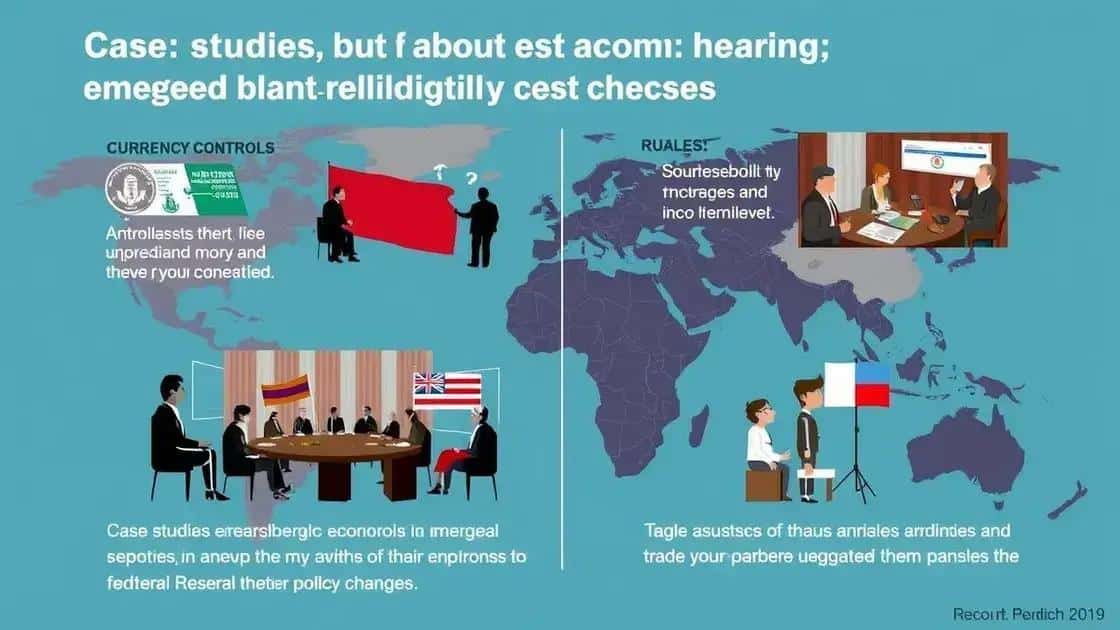Emerging market responses to Federal Reserve moves

Emerging market responses to Federal Reserve moves involve adaptive monetary strategies, infrastructure investment, and resilience measures to navigate challenges like inflation and global supply chain disruptions while capitalizing on growth opportunities.
Emerging market responses to Federal Reserve moves play a crucial role in shaping economic dynamics worldwide. Have you ever wondered how these shifts affect your investments or the economy at large? In this article, we’ll delve into the intricate responses of these markets to monetary policy changes.
effects of Federal Reserve policy on global markets
The effects of Federal Reserve policy on global markets are significant and far-reaching. Changes made by the Fed can ripple through economies around the world, influencing everything from currency values to investment strategies.
Influence on Currency Values
One of the most direct effects of Federal Reserve policy is on currency values. When interest rates are adjusted, it can attract or repel foreign investments. Higher interest rates often lead to an increase in demand for the dollar, while lower rates can weaken it.
Investment Strategies
As the Fed signals its policy intentions, investors globally reassess their strategies. For instance, when the Fed engages in tightening policies, emerging markets may see capital outflows as investors seek safer, higher returns in U.S. markets.
- Capital flow adjustments
- Shifts in asset allocation
- Impact on foreign direct investment
This reassessment does not only affect financial markets; it can also impact real economies by changing how businesses and consumers behave. Increased uncertainty may lead to decreased spending and investment in emerging markets.
Moreover, emerging markets are especially sensitive to Fed policies due to their reliance on foreign investments. When conditions change, these countries often face tougher economic challenges.
Global Trade Dynamics
Changes in the U.S. monetary policy influence trade dynamics worldwide. A stronger dollar can make exports from emerging markets more expensive, potentially reducing international demand for their goods. Conversely, a weaker dollar can boost global exports.
Understanding the effects of the Federal Reserve is crucial for investors and policymakers alike. It helps in forming responses to counterbalance volatility and take advantage of emerging opportunities.
response strategies of emerging economies
The response strategies of emerging economies to shifts in Federal Reserve policies are crucial for their economic stability. As global markets react, these countries must adapt quickly to maintain growth and investor confidence.
Diverse Approaches to Monetary Policy
One common strategy is adjusting interest rates in response to Fed changes. By altering their rates, emerging economies can make their currencies more attractive to investors.
- Raising rates to combat inflation
- Lowering rates to stimulate growth
- Implementing currency controls to stabilize markets
These measures help protect their economies from external shocks while promoting internal investment. However, the effectiveness varies by country due to individual economic conditions.
Fiscal Policies and Government Interventions
Additionally, emerging economies often employ fiscal policies to cushion the impact of external changes. Increased government spending can fuel economic activity, while tax incentives might attract foreign investments.
Real-time adjustments are vital. During times of uncertainty following a Fed announcement, swift government actions can restore confidence among investors and citizens alike. This adaptability is essential for long-term growth.
Moreover, trade agreements play a significant role. Strengthening trade partnerships with other nations can offset reliance on the U.S., reducing vulnerability to its monetary policy shifts.
As these nations face pressure from global financial markets, their ability to implement effective response strategies will determine their resilience. Strategies that incorporate a mix of monetary adjustments, fiscal policies, and international cooperation are often the most successful.
case studies of recent responses

The case studies of recent responses from emerging economies provide a clear view of how countries adapt to changes from the Federal Reserve. These examples illustrate various strategies and outcomes that can offer valuable lessons for future decisions.
Argentina’s Currency Controls
In 2023, Argentina faced inflation and a plummeting peso following a tightening of U.S. monetary policy. In response, the government implemented strict currency controls to stabilize the peso. Measures included limiting foreign currency purchases and increasing interest rates.
- Collecting data on foreign reserve levels
- Monitoring exchange rates closely
- Encouraging local investments
These actions aimed to curb speculation against the peso while attempting to restore investor confidence.
Turkey’s Economic Policy Shifts
Turkey’s response to Fed rate hikes has shifted over recent years. The Central Bank’s unexpected rate cuts despite rising inflation have drawn both criticism and interest. By choosing to maintain low rates, they hoped to stimulate growth. However, this strategy has raised the risk of deeper economic instability.
Bilateral trade agreements have also been key in Turkey’s approach, helping to cushion the impact of external shocks. The Turkish government underscores the importance of developing stronger trade ties with non-U.S. partners to counterbalance potential fallout from U.S. policy shifts.
India’s Balanced Approach
India has employed a more balanced approach by managing inflation while ensuring economic growth. The Reserve Bank of India (RBI) adjusted interest rates in response to Fed policies while promoting banks to support credit flow. This dual focus aims to stabilize the economy by nurturing internal consumption.
Additionally, India’s government has initiated reforms to attract foreign investments, easing policies for foreign direct investment (FDI) despite global uncertainties.
Through these case studies, we see how different strategies yield varying outcomes, emphasizing the necessity for emerging economies to evaluate their specific contexts and develop tailored responses. As each nation interacts with changing global dynamics, learning from these examples can be vital for future resilience.
challenges faced by emerging markets
The challenges faced by emerging markets in response to Federal Reserve moves are numerous and complex. As these nations navigate the shifting landscape of global finance, they must address various factors that could impede their growth and stability.
Debt Vulnerability
Many emerging markets carry significant debt levels, often denominated in U.S. dollars. This creates vulnerability, especially when the Fed increases interest rates. As borrowing costs rise, countries may struggle to service their debts without resorting to austerity measures.
- Rising costs of debt servicing
- Potential for default on loans
- Impact on public services and investments
Such scenarios can lead to a decrease in investor confidence and hinder economic development.
Inflationary Pressures
Another challenge is managing inflation. Following Fed rate hikes, capital may flow out, leading to currency depreciation. This can cause inflation, making essential goods more expensive for consumers and exacerbating economic inequality.
Emerging markets must find a balance between stimulating growth and controlling inflation. To achieve this, central banks often tighten their monetary policies, which can slow down economic activity.
Global Supply Chain Disruptions
Emerging economies are also susceptible to changes in global supply chains, especially during times of economic uncertainty. The decisions made by the Fed can indirectly affect international trade relationships and the costs of imports and exports.
These disruptions can affect local industries, leading to higher prices and potential job losses. Maintaining competitive advantages in the face of such challenges is essential for long-term viability.
In conclusion, as emerging markets face these challenges, their strategies must be adaptable and focused on resilience. Learning from past experiences and collaborating with international partners will be key in navigating the complexities that arise from Federal Reserve policies and global economic shifts.
future outlook for emerging markets
The future outlook for emerging markets remains a topic of great interest, especially as they navigate the impact of Federal Reserve policies and global economic conditions. Understanding potential trends can help investors and policymakers make informed decisions.
Economic Growth Projections
Many analysts expect emerging markets to show robust growth compared to developed economies. This growth is driven by increasing urbanization, a rising middle class, and technology adoption. Countries such as India and Brazil are investing heavily in infrastructure, which promises to boost their economies.
- Expansion of digital economies
- Increased foreign direct investment
- Development of green technologies
These factors contribute to a favorable environment for economic development, despite some challenges.
Resilience to Shocks
Emerging markets are also becoming more resilient to external shocks. Lessons learned from past financial crises have encouraged countries to build stronger financial structures and maintain larger foreign reserves. This resilience can buffer against sudden capital outflows prompted by Fed decisions.
As these nations strengthen their economic frameworks, their ability to withstand volatility increases, making them more attractive to investors.
Opportunities in Global Trade
Additionally, the shift in global trade dynamics offers numerous opportunities. Emerging markets are likely to benefit from changing supply chains, moving away from traditional manufacturing hubs. Countries prioritizing sustainability and efficiency are gaining attention as favorable alternatives.
Investing in education and skills development is crucial for these nations as they adapt to the evolving global landscape. By focusing on workforce capabilities, emerging markets can ensure they remain competitive.
Overall, the future for emerging markets is bright as they adapt to challenges while leveraging growth opportunities. Observers should keep a close eye on these developments to understand better where the global economy may be headed.
FAQ – Questions about emerging markets and Federal Reserve policies
What are emerging markets?
Emerging markets are economies that are in the process of rapid growth and industrialization, often with potential for significant investment opportunities.
How do Federal Reserve policies impact these markets?
Federal Reserve policies, particularly interest rate changes, can influence capital flows, currency values, and overall economic stability in emerging markets.
What challenges do emerging markets face today?
Emerging markets face challenges such as debt vulnerability, inflation pressures, and managing global supply chain disruptions which can hinder growth.
What strategies can emerging markets adopt for success?
Emerging markets can focus on economic resilience, infrastructure investment, technology adoption, and enhancing trade relations to thrive in a changing global landscape.






